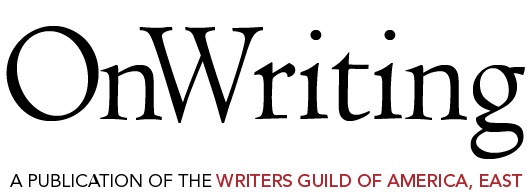
James Schamus could rest on the laurels that come from a successful run as CEO of Focus Features, Executive Producing BROKEBACK MOUNTAIN and being the screenwriter of CROUCHING TIGER, HIDDEN DRAGON and THE ICE STORM. Instead, Schamus challenged himself to step out of his comfort zone and into the director’s chair.
INDIGNATION is pure Schamus: masterful, elegant and intricate in all its detail. His screenplay and cinematic vision succeed on screen in a way that is not often achieved with adaptations of Philip Roth novels.
OnWriting spoke with Schamus about his first experience as a Writer/Director, his writing process and the challenges of adapting a Roth novel.
What attracted you to INDIGNATION as your first project as Writer and Director?
Well, I had the luxury of having been fired from my studio job running Focus and had a certain amount of additional free time on my hands. To be honest I hadn’t planned on jumping into the director’s chair, but my friend Ang Lee, for whom I tend to write, was otherwise occupied. I thought it was as good a moment as any to try something new in my advanced middle age.
Did you work on your screenplay differently knowing you were going to direct the film?
No. I tend to be a bit of an under-writer by Hollywood standards. I like to leave a lot of room for directors and other collaborators to maneuver, while giving as strong a backbone as I can to the story and to the characters. I did not change my method this time around.
As a director, did you find it challenging working with a script that was under-written? How did you use that to your advantage or disadvantage?
I had the benefit of having about three decades of producing under my belt. I had a pretty good idea of the kinds of questions that a screenplay should spur to a creative team, as well as the inevitable logistical and budgetary issues.
It wasn’t so much that my perspective was different as it was that I was faced with the rather fun challenge of an entirely new job. I now had to answer questions which before I had never been asked to answer. I’d only been asked to pose and sometimes to help solve.
Can you give me an example of a question that came up that you had never dealt with being asked?
Nobody ever asked me where to put the camera before. It turns out you can put it anywhere.
That’s a good question to answer.
Let me tell you, it’s a truthful answer. It’s scary the first time you realize, “Oh, we actually have to make that decision every single day. Many times.”
 How did you end up adapting Philip Roth’s novel? Did you seek out the project or did it come to you?
How did you end up adapting Philip Roth’s novel? Did you seek out the project or did it come to you?
I actually came across the novel at the airport. I read it primarily for the pleasure of reading a Philip Roth novel. I had no instrumental intent when I picked it up.
Was there a point where you knew you wanted to turn this into a film?
Yes. By the time I finished it, I thought that the characters had come so to life for me. I found the book led me to believe that I might be able to overcome some of the rather famous difficulties in adapting Roth for the screen. Primarily, the difficulties that have to do with the particular tenor and voice of his work.
How do you go about adapting a book to a screenplay? What is your process of breaking down the book?
I have a very specific and advanced process. I try to transcribe all the good dialogue I can from the book. Then wrap sluglines and character descriptions around that. Type the end and pray that that works.
And that works?
Never. It’s a disaster. That’s when the next two years of just making stuff up starts to happen.
What other kinds of materials do you like to surround yourself with when you’re writing?
I have an academic background. My day job is teaching at Columbia. This is what is called my nerdist predilections. I love to surround myself with as much other material as I possibly can. I read a lot of work both fiction and nonfiction from the era. I did a lot of research, especially audio-visual research. I looked at history, material culture, pop culture and music of the era. I try to enrich myself in the world.
What kind of environment do you like to be in when you are writing? Do you surround yourself with these different materials or do you just kind of work off of the knowledge that you’ve acquired and see how you can fit it in to scenes?
The research is organized pretty extensively and in a way that I can access remotely. With my assistant I create a Dropbox that has thousands and thousands of items in it by the time I finish the script.
Do you feel that there were certain scenes that translated from the page to the screen?
Although it took a lot of work, a lot of shaving, a lot of elision and transitional work, but there is a scene that is essentially a scene I transcribed from the book that did survive intact. It is a central scene in the movie and seems to be getting a lot of attention. It is a discussion between our young hero, Marcus Messner, and the dean of men, Hawes Caudwell, played by Tracy Letts.
The scene blows past what is usually considered a maximum length for a scene between two characters in American movies. As your readers will know, they’ll often start getting marginal notes back from their studio producers once they start crawling past page three or four. This is a scene that when we shot it ran 18 minutes. I let things play. I crafted the scene and developed it to have a structure that I thought would work dramatically. And so far for audiences, it seems to have gone over pretty well.
Have you heard from Phillip Roth about his thoughts on the film?
I did something very stupid before we started pre-production. In good conscience, I couldn’t not do it. I had sent the screenplay to him knowing that if he had disliked it, I probably would have called off production.
Luckily, he did me a great favor. He refused to read the screenplay. That was a great relief. It’s actually a gift to me to say, “Go make your movie.” When we finished the shoot and had some time in the edit room, I did share a cut with him and it was great. He was really engaged. We had an amazing conversation. He even wrote some very beautiful words about the film that my producer was able to read out loud at our world premiere at Sundance. I get to claim to be one of the lucky Roth adaptors.
What was it like being the person receiving notes as a director and as a writer? Was it a different experience for you?
The good news was we made the film for such a low price and so under the radar that the notes process was really more an ongoing discussion with my creative team. I never got official studio notes. Having given them out as the head of a studio and head of a production company for a combined total of close to 30 years, I have no fear of notes, good or bad. I simply didn’t have occasion to receive them on this movie.
Are there fundamental steps you apply to your own writing based on notes you may have given to other writers?
As I often say, “When you finish writing a poem, you have a poem.” When you finish writing a screenplay, you basically have a certain number of pages begging for money. It’s a rhetorical as well as an aesthetic document. That’s the form. Screenplays are appeals to people to do a lot of things in order to make a movie. With that said, I do my best not to have an internal dialogue while writing with the powers that be. I think once I set course, and if I believe the course makes sense, I try not to self-censor.
What is your view of how screenwriters are valued today by studios?
I think the challenges for writers remain… Let me put it this way, it’s changed because the industry continues to change. That always throws up new challenges for creative people, including writers. Yes, it is different now than it was when studio heads would walk through the writer’s building on the lot and listen for the sound of typing to make sure people were working. It’s certainly different now.
We’re seeing many Writer/Directors who have worked for decades in feature films moving towards television. Is that something that you could envision yourself doing in the future?
Of course. Remember the 1950’s, when so many great screenwriters came up through television. You know, the Paddy Chayefsky-s and folks like Walter Bernstein.
INDIGNATION takes place in 1951 at the height of the blacklist era. The House Un-American Activities Committee was engaged in an assault on the screenwriting community in particular and the American film business. It’s an honor to be able to pay homage to some of the people who have come before us, who’ve fought to preserve precisely the kind of creative freedoms that we’re still in the trenches fighting for today.
Early in INDIGNATION, there’s a scene in a synagogue. In the front row, I placed a certain extra by the name of Walter Bernstein, who was himself in 1951 a blacklisted writer.
Are there films you recommend to other writers or directors that you find inspiring?
As a first-time director, I refused to do that ritual that first-time directors often do, which is screen their favorite movie for the crew. I allowed for a multiplicity and heterogeneity of influences to work on me in this project. I hoped that most of the most powerful ones remain subconscious, even to me, because I think that allows you a certain kind of freedom. That said, it doesn’t mean that I’m not completely indebted and inspired by many other films and filmmakers. For my first film at least, I tried not to cordon off one or two inspirations in particular.
Is there a line of dialogue from INDIGNATION that you think really encapsulates the film and why?
Yes. It’s taken directly from the book so I can’t claim any originality to it. It’s when our hero turns to the big authority figure on campus, the dean, at the end of the movie and says “Fuck you, it is!”
Follow James Schamus on Twitter at @JamesSchamus

